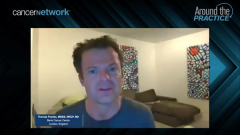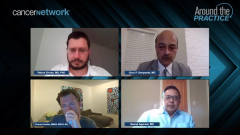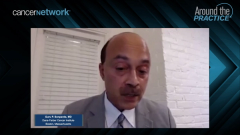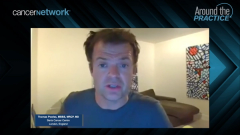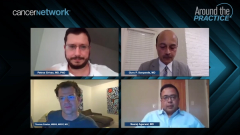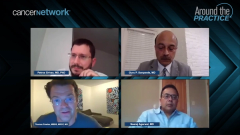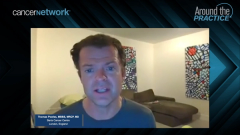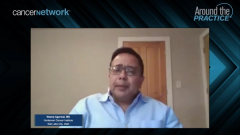
Role of Maintenance Therapy in Advanced Urothelial Carcinoma
Petros Grivas, MD, PhD; Guru P. Sonpavde, MD; Thomas Powles, MBBS, MRCP, MD; and Neeraj Agarwal, MD, provide insight on how they approach the patient selection of maintenance therapy in advanced urothelial carcinoma.
Episodes in this series

Petros Grivas, MD, PhD: Let’s go to another polling question for the audience: Do you think first-line maintenance therapy has a role in the management of advanced urothelial cancer? To clarify, this is for patients with either response or stable disease to induction platinum-based chemotherapy. The options are: yes, it should be offered to all patients, assuming with response or stable disease; it should be offered to certain patients, and I would like to discuss what that means; no, there isn’t sufficient evidence of benefit; no, there’s risk of overtreatment; and no, for other reasons. I’d like the audience to vote concerning the role of maintenance therapy with avelumab, and we can discuss the data in a second.
As we get the answers coming in, Tom, you’ve been 1 of these people who believed in the maintenance strategy for many years. You had a related trial with maintenance lapatinib in this field. It was a negative trial but definitely important. What are your thoughts about the concept of maintenance therapy and what led you to follow the design of the JAVELIN trial?
Thomas Powles, MBBS, MRCP, MD: The original lapatinib trial that we did was, I think, the first idea that I came up with when I was first appointed a CE [continuing education] lecturer. The principle was that we could see patients do well with chemotherapy, but resistance occurs very quickly. There’s a real frustration. It’s a V-shaped curve, and the cancer comes straight down. Then you stop chemotherapy, and it bounces back up again. The principle is, can we maintain that great control we initially get? We often compare lung cancer and bladder cancer and bladder cancer and pancreas cancer, but the response rates to the chemotherapy are pretty high, actually. There’s a difference. The problem is that resistance occurs so quickly. The principle was, and we’ve talked about this before, that second-line therapy is too late for most patients. Even in patients who get second-line chemotherapy, or dare I say it, second-line immune checkpoint inhibitors—from Neeraj’s data, we know that’s the minority of patients in the community—the cancer is growing quite fast by then and immune checkpoint inhibitors aren’t great at getting control of the disease when the cancer is growing fast. No drug is.
The principle really was, can we maintain that control? The lapatinib trial was very negative; a minority of patients overexpressed HER1 [human epidermal growth factor receptor 1] and HER2 [human epidermal growth factor receptor 2]. There’s a question about whether we measured it correctly, which is a discussion for a different day. But when the immune checkpoint inhibitors came out, it became apparent that second-line immunotherapy with pembrolizumab was too late for some of the reasons we discussed earlier, and first-line immune checkpoint inhibitors didn’t get it under control for enough patients. It’s that Goldilocks effect of not too late and not too early, which is why the trial turned out to be a success.
Petros Grivas, MD, PhD: Thank you, Tom. It’s great to see this background and rationale. Just to let you know the audience answer. Two-thirds, 63%, answered yes—they offered maintenance therapy in all patients—a great deal because of JAVELIN, I assume. Twenty-seven percent said yes to certain patients. Only 9%said they don’t offer it.
Guru, do you offer avelumab maintenance to all patients with response or stable disease, assuming no contraindication based on maybe active autoimmune disease? Or do you use it in certain criteria of a subset of patients?
Guru P. Sonpavde, MD: Good question, Petros. In general, I offer maintenance avelumab to all the patients who satisfy the criterion in the trial, which was responding or stable disease. That includes CR [complete response], PR [partial response], or stable disease with 4 to 6 cycles of platinum-based chemotherapy. The only situation where I have a little doubt is patients who had lymph node–positive disease only and have a really solid complete remission. Are we treating many of these patients excessively? Overtreating them? We’re clearly overtreating some of them, but we don’t know who they are. One of the beauties of this paradigm is that you’re getting the second-line treatment early, so you deliver second-line treatment to everybody, essentially early second-line treatment, which is a major benefit in this paradigm. In general, I offer it to everybody for at least a period of time, even in the CR patients.
Petros Grivas, MD, PhD: Thanks, Guru. I do the same thing. I offer it to all patients. With Professor Powles, we presented the data with the rest of the team at previous meetings. Based on the treatment by subgroup interaction, the benefit was across the board with different degrees of benefit. Obviously, when you’re getting small numbers, it’s hard to show significance in every subset analysis. But I agree with you: I offer it to all patients, including those with complete response.
Before I ask Tom to discuss a bit more about the JAVELIN trial, Neeraj, I have question for you. What barriers do you see in colleagues in community oncology practice or even academia in following the JAVELIN paradigm and why you think maybe some of those providers may not use maintenance therapy?
Neeraj Agarwal, MD: First, this is the only opportunity for our patients to receive any immunotherapy in first line if they’re receiving chemotherapy. As Tom just said, all other trials are negative; we know that. That’s No. 1. No. 2, the most common argument I hear is, “We have pembrolizumab in second-line setting. Why shouldn’t we just wait until second line and not overtreat many of those patients who may not progress?” First, I’ve rarely seen any patients who don’t progress after cisplatin- or carboplatin-based chemotherapy. Overwhelming majority do. If you ask me to think about it, I can count those patients on my fingertips.
The vast majority of patients are progressing. I also remind them that more than half of these patients, or even worse—if you believe our data, only one-fifth of these patients—are ever going to receive second-line therapy because they go downhill so fast. Based on those 2 reasons, I don’t have any reason to wait for disease progression before I can talk about immunotherapy. For me, this is a fantastic opportunity for our patients to receive an immunotherapy in the first line without waiting for disease progression.
Petros Grivas, MD, PhD: Thank you, Neeraj. As you and Guru mentioned, we don’t have the reliable biomarkers to predict who’s going to stay in durable control. The risk of overtreatment is probably overshadowed by the risk of undertreatment, to your point. That’s what drives me to offer avelumab maintenance in all patients if they have response/stable disease.
Transcript edited for clarity.
Newsletter
Stay up to date on recent advances in the multidisciplinary approach to cancer.



